Cross stitch vs embroidery: a beginner's guide
If you’re a newbie to the world of needlework, then you may be surprised to find that cross stitch and embroidery are unique crafts in their own rights. Despite both being methods of hand stitching that use a needle and thread to create beautiful designs on fabric, they are worked using fairly different processes.
We break down those differences to help you to find out the benefits of each to help you decide which craft is for you! Plus, when you’ve decided to embark on your stitching journey we’ve got you covered with our comprehensive guides for how to cross stitch and embroidery for beginners.
Jump to:
- How is cross stitch different from embroidery?
- Can you cross stitch an embroidery pattern?
- Do you need different tools for cross stitch compared to embroidery?
- What's next?
Cross stitch vs embroidery: what's the difference?
Cross stitch
Both cross stitch and embroidery are brilliant in their own right, but there are some key differences between the two.
Cross stitch is arguably simpler, as it’s formed of just a few types of stitches that are worked in a grid formation. It also requires you to follow a pattern (chart) and key to show which colours and stitches to use, and where to place them.
That pattern is used in combination with specially designed fabric that has an even grid of holes, then you simply count the squares on the pattern and stitch them onto the corresponding position on the gridded fabric.
Embroidery
Embroidery, on the other hand, usually involves transferring a template outline directly onto any fabric (often cotton) of your choosing and filling that outline with stitches. You can either use the designer's suggested colours and stitch types or select your own.
There is also much more of a variety of stitches to choose from, which tend to be more complicated than those found in cross stitch, but you will notice some cross over between the two. Keep reading to find out more as we’ll be going more in-depth throughout this article.
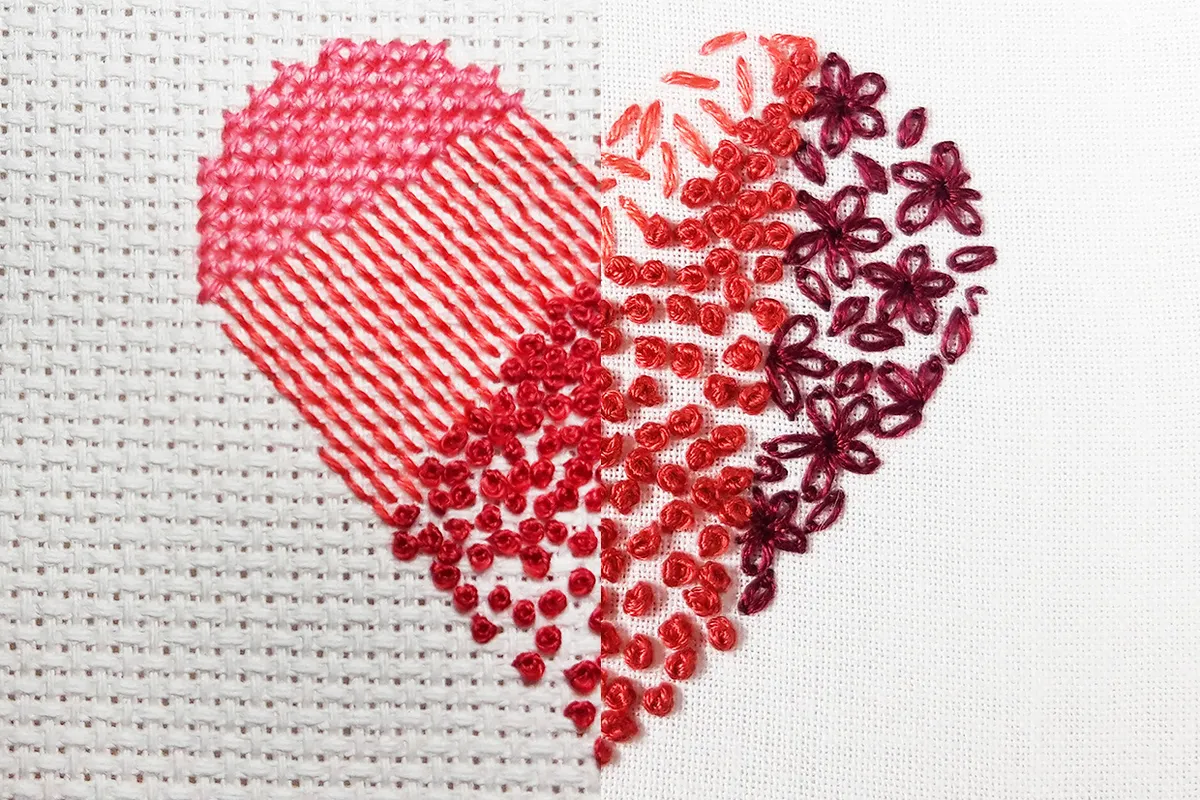
What is cross stitch?
Counted cross stitch is made up of x-shaped stitches worked onto a fabric with an open, evenly-spaced weave called aida, evenweave and linen. The finished appearance is similar to pixel art or diamond painting because of its grid formation.
It consists of five main types of simple stitches which are: whole cross stitch, half cross stitch, fractionals, backstitch, and French knot.
The designs are formatted as a pattern and a key, which together show you the positioning of each colour and stitch. You then use the pattern to stitch the corresponding colour onto your fabric working outwards from the centre of the design and fabric.
The World of Cross Stitching is the ideal magazine for those looking to get into cross stitch as it’s full of fun projects for all difficulty levels, starting from beginner all the way to advanced.
What is embroidery?
Hand embroidery is the art of decorating fabric using a needle and thread. The finished appearance is more like a painting or drawing. You’re not limited to a grid format as you are with cross stitch.
It is most commonly worked using stranded cotton thread on cotton fabric. However, it can be worked on many different types of fabric using a variety of threads. It often incorporates other materials such as beads and sequins.
There are literally hundreds of types of embroidery stitches to choose from. However, these are the most common embroidery stitches:
If it sounds like embroidery might be your thing, then check out Love Embroidery Magazine. Each issue is packed with modern, on-trend designs suited to all levels of stitching.
Can you cross stitch an embroidery pattern?
Although you can’t simply use the pattern from one craft for the other, with some editing, it is possible to stitch an embroidery pattern using cross stitch provided it is a simple design.
Anything too small or detailed will be difficult to replicate on the gridded fabric using cross-shaped stitches. The finished piece will also have a more angular and jagged appearance than that you would achieve using embroidery.
To work an embroidery design using cross stitch, simply transfer the outline onto the fabric. Then fill the sections with your chosen colours using the traditional cross stitch techniques.
Alternatively, you could draw a square grid over the template. Then work the design onto the fabric using the counted method.
This is an example of how an embroidery design would look once transferred onto cotton fabric (left). Here's how Aida fabric looks (right), both using a heat-erasable pen.
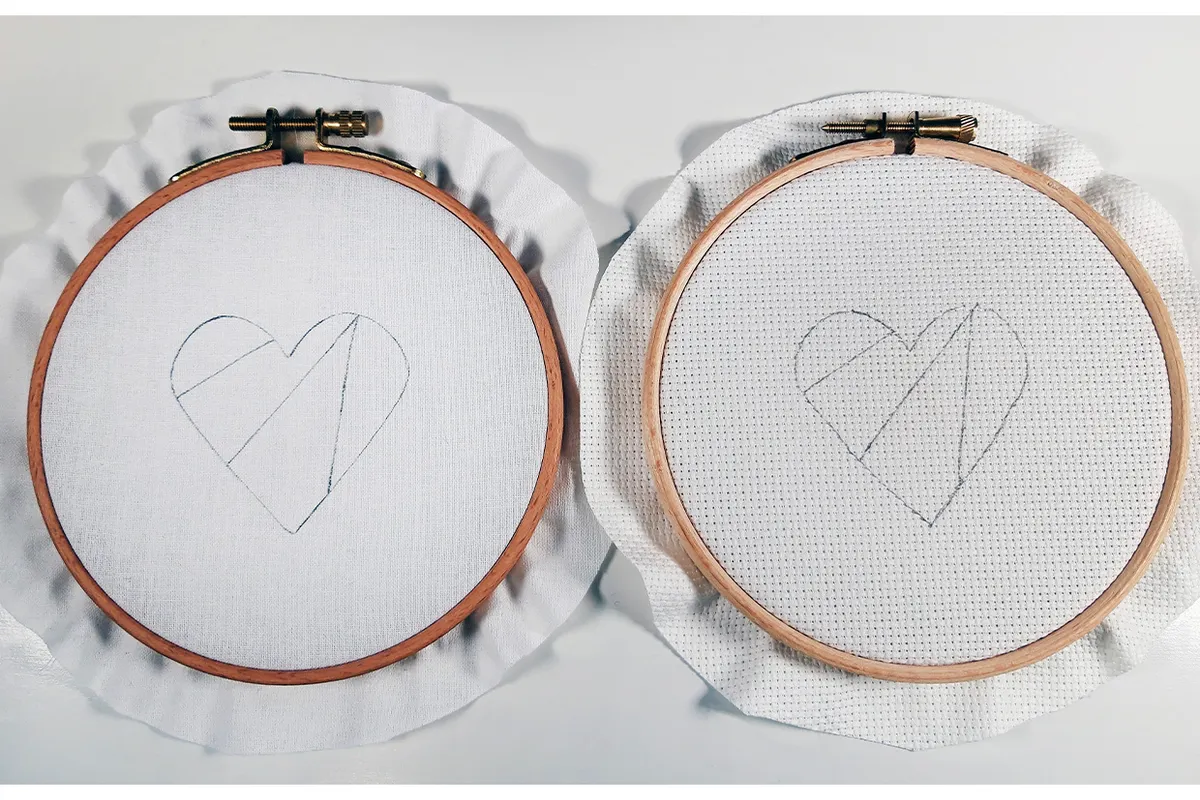
Here we have shown how you might stitch the embroidery design onto cotton fabric. Here we have used the traditional embroidery stitches satin stitch, seed stitch, lazy daisy stitch, and figure of eight knot
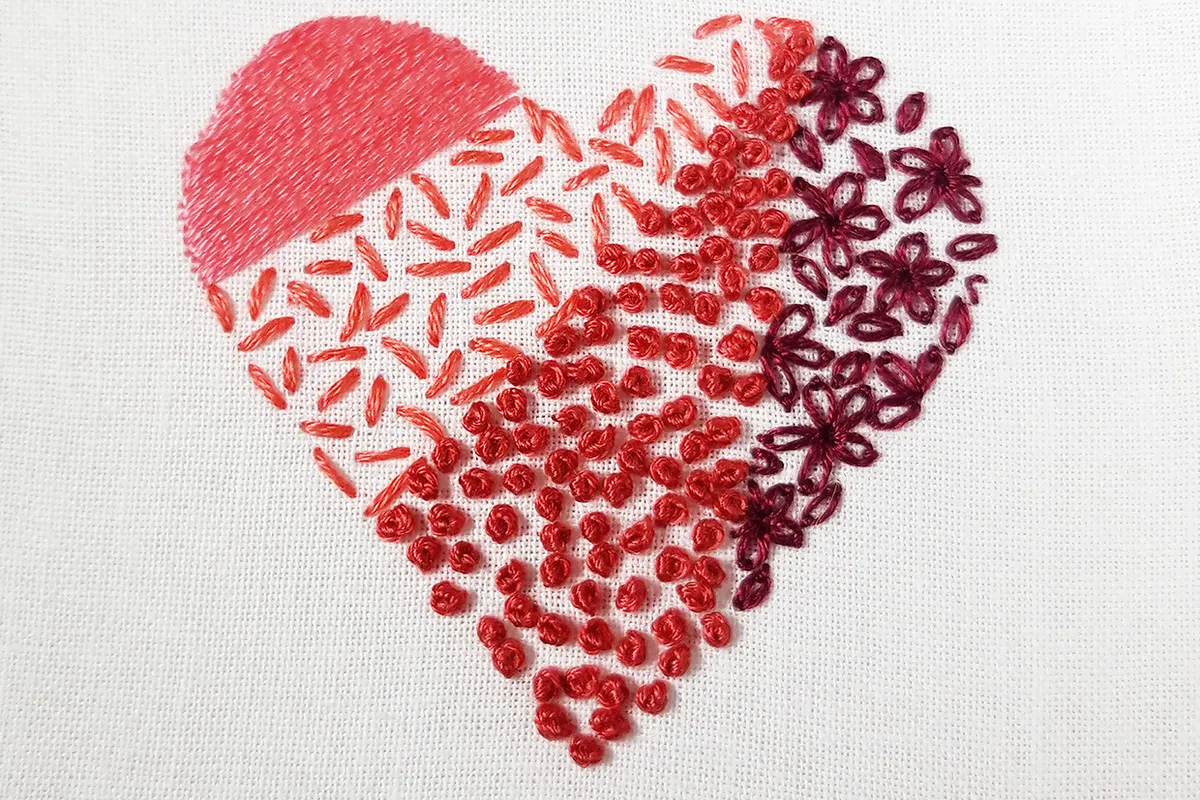
We stitched the cross stitch version of the design using whole cross stitch, half cross stitch and French knot
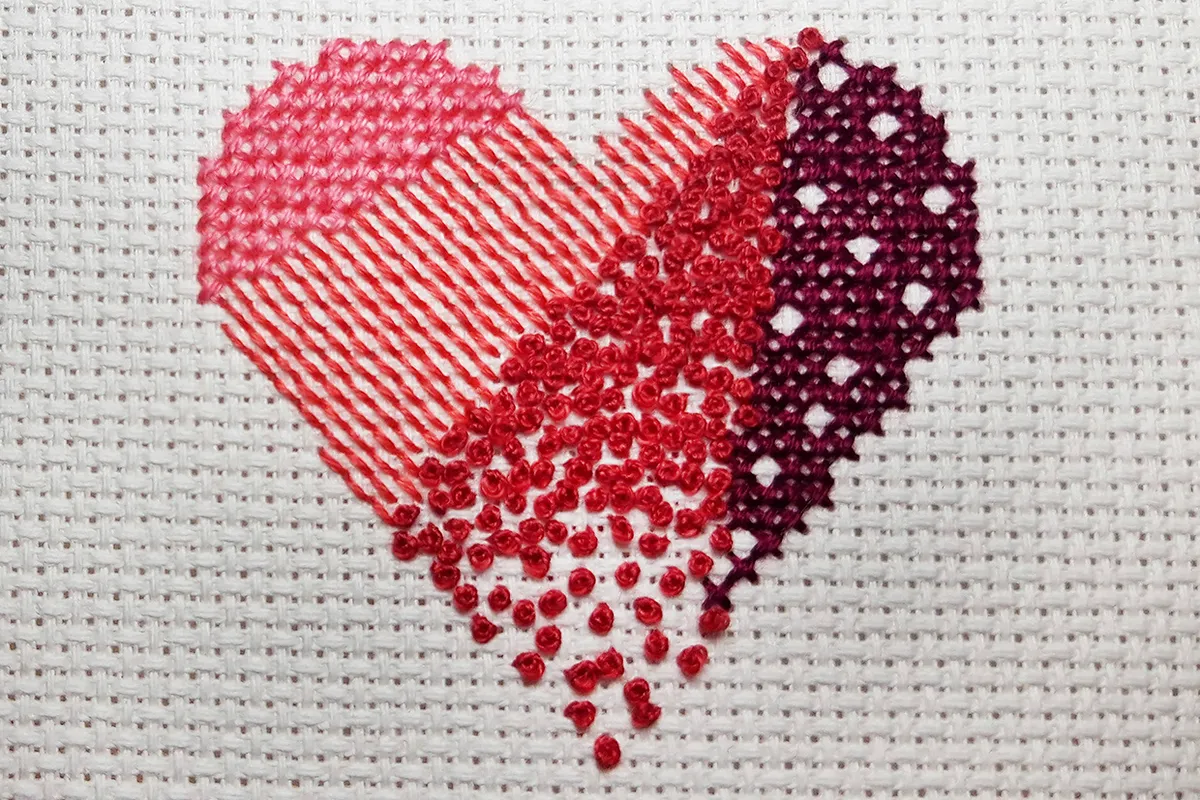
Do you need different tools for cross stitch compared to embroidery?
Cross stitch and embroidery have their own unique set of equipment as well as some crossover items. Before you jump into your chosen craft, you will need to stock up on a few essentials.
Fabric for cross stitch vs embroidery
Cross Stitch uses specific fabrics, such as evenweave, aida and linen. These fabrics have holes in the weave of the fibres that are spaced evenly across the fabric. These help you work precise square stitches. This type of fabric is essential. It is needed to work in conjunction with the patterns/charts which are formed on a grid. Cross stitch can also be worked on plastic canvas, perforated paper and other types of fabric if you use waste canvas or soluble canvas. These add a grid to any material and are removed after the stitching is completed.
Embroidery, on the other hand, is most commonly worked on quilting-weight cotton fabric. These are easy to stitch on, have a good solid colour and don’t stretch as you stitch.
However, it can be worked on a wide variety of fabrics and materials with the aid of fabric stabilisers and interfacing. Embroidery can easily be used to customise garments, furnishings and accessories.
Needles for cross stitch vs embroidery
Cross stitch is best stitched using tapestry needles. These have a large eye and a blunt tip, which will gravitate towards the holes in the Aida or even weave. They'll also be less likely to accidentally pierce the fabric.
If you are working on a project that contains a lot of fractional stitches, then it will be easier to switch to a crewel needle for those stitches. Fractional stitches require you to stitch through the centre of the square (known as breaking the block).
The most common types of needles for stitching embroidery are crewel/embroidery needles. These are sharp and are designed to easily pierce the fabric. Using a sharp needle means that you can insert the needle anywhere on the fabric, without conforming to the structure of the weave.
More specific types of needles may be required when working on unusual fabrics such as leather. They may also be needed for attaching beads to a design. Or when stitching using different types of thread, such as yarn.
SQUIRREL_13208060

SQUIRREL_13208062
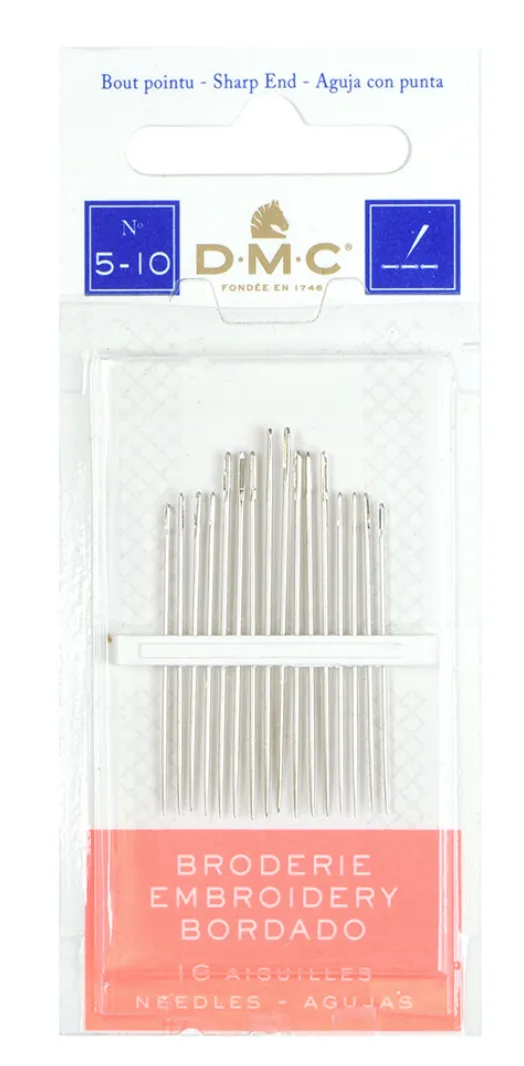
Transferring the design for cross stitch vs embroidery
Embroidery requires specific equipment to transfer the template onto the fabric. There are lots of different methods of transferring, including carbon paper, soluble stabiliser, and iron-on transfers.
However, the most common method is to use a light source (such as a window or a lightbox) and a pencil or erasable pen (either heat- or water-erasable, depending on your preference). Sometimes a project will specify a particular method, but often it’s up to you which is your preferred one.
Lightbox:
Heat erasable pens:
Threads for cross stitch vs embroidery
The most common type of thread used for both types of stitching is stranded cotton. It comes in a vast selection of colours. This means you can stitch your design in almost any colour and create subtle shading.
Stranded cotton is made up of six strands of cotton which have been combined. Before stitching is normally separated into individual strands and then recombined to adjust the thickness of the thread.
Your project will usually tell you a suggested number of strands to use but there is also a recommended number of strands when cross stitching on different sizes of aida/evenweave.
DMC Threadship 6-Strand Thread - 150 Skein XL Pack
Get your kit off to a great start with these high-quality threads. In the pack, you'll receive 150 assorted colours, each of which is 9m in length, so you will have plenty of choice on colour when it comes to taking on your next project.
These threads are 100% cotton and perfect for both embroidery and cross stitch. When you have your threads make sure your first project is a colourful one to try out all the new colours! Why not try the kindness embroidery pattern which uses lots of different colours, and is great for beginners.
SQUIRREL_13208072

Hoops and frames for cross stitch vs embroidery
Although not always essential, an embroidery hoop or tapestry frame is used for both types of needlework to keep the fabric taut while stitching and to help the stitcher hold the material.
Embroidery hoops come in a range of sizes, starting as small as 2.5in flexi hoop and can go as big as 23in quilting hoop. Choose a hoop that is slightly larger than the project you are stitching.
They also come in a range of shapes and can be made of a selection of materials, including flexi hoop, plastic, bamboo and wood.
Tapestry frames also come in a range of sizes, starting from around 9x12in to around as large as 39x12in. They come with two different methods of attaching the fabric to the frame, easy clip and rotating sew on.
Embroidery hoops can also be used as an easy way to display your stitching.
Hoops, frames and stands
If you are in the market for any embroidery or cross stitch tools, Amazon, Etsy or Hobbycraft is the place for you. They have a huge selection of hoops, frames and stands available.
From the classic wooden hoop to free-standing work stands, perfect for your bigger projects. You can even get mini embroidery hoops, ideal for the tiniest of projects!
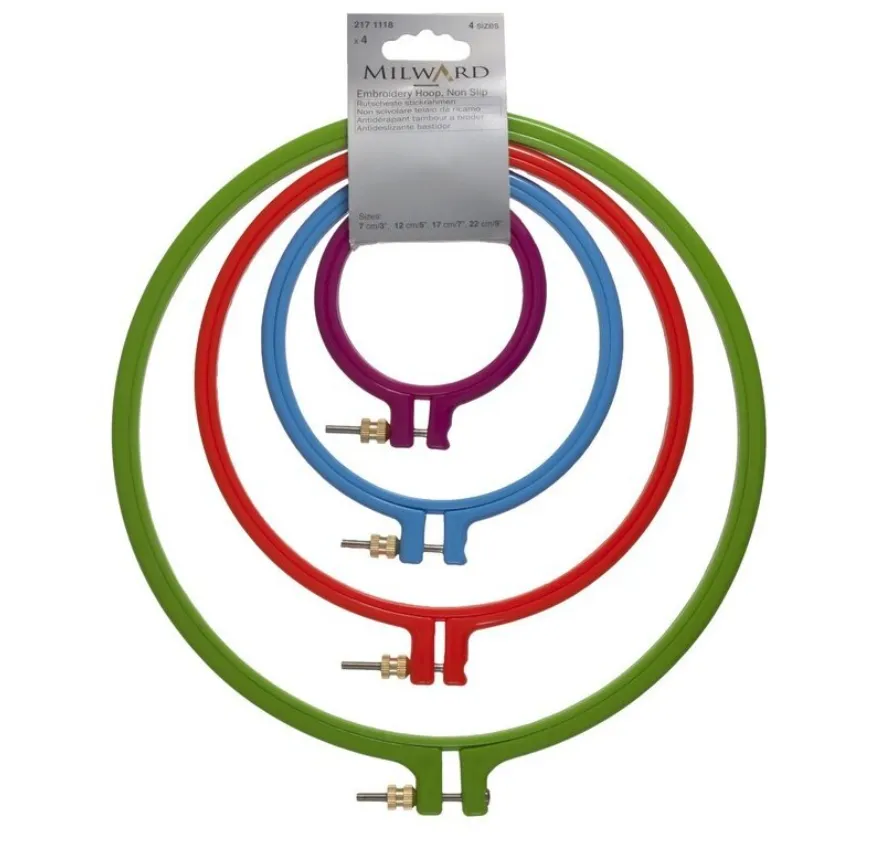
Deciding between cross stitch and embroidery
Cross-stitch is the ideal craft for methodical people. It is a great mindful activity to ease away the day’s stresses.
Embroidery is better suited to people who like to improvise. Those who want to add their own creative spin on the design will love embroidery.
Start simple with all needlework
Why not have a try at a simple, beginner-friendly project? This wolf cross stitch pattern is worked in whole cross stitch and backstitch. This makes it perfect for those who are complete novices.
For a simple starter project using embroidery, try this cultivate kindness project, worked using four basic stitches. It contains six easy-to-follow steps for how to stitch and links to detailed instructions for working each type of stitch.

